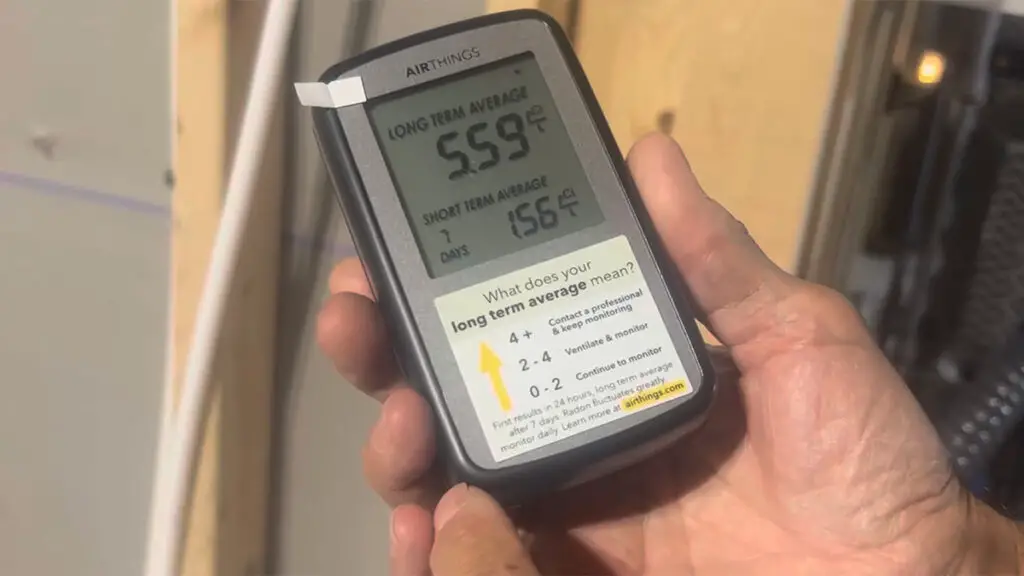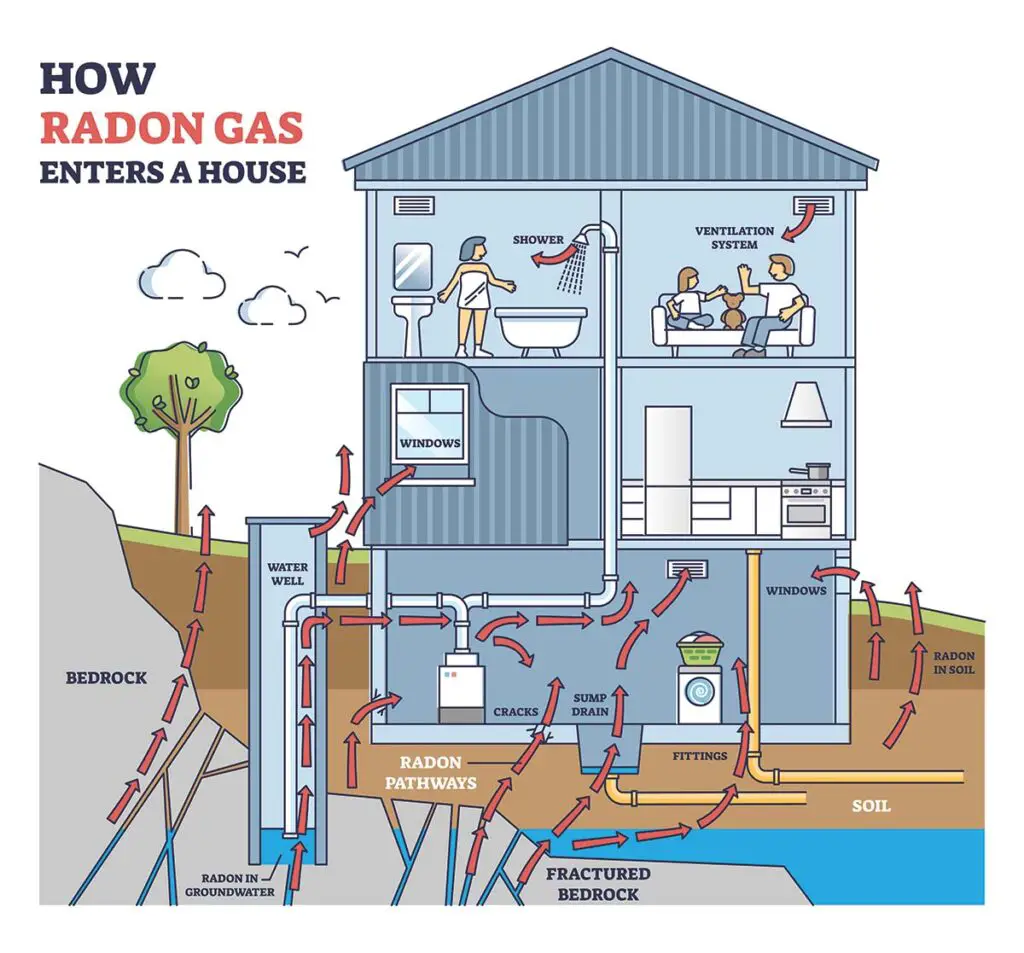Radon is a colorless and odorless radioactive gas that can harm human health. It is formed naturally from the decay of uranium in rocks and soils. Radon can enter homes and buildings through cracks in the foundation, walls, and other openings.
Prolonged exposure to high levels of radon gas can increase the risk of lung cancer. You should have a radon test for radon levels in homes and take appropriate measures to mitigate its presence if necessary.
When considering a radon test for your home, it’s essential to understand the types of tests available, how to conduct them, and the implications of the results.
Key Takeaways
Radon 101:
- Radon is a radioactive gas that forms naturally from the breakdown of uranium in soil and rock.
- It seeps into homes through cracks in foundations, basements, and crawl spaces.
- Since it’s colorless, odorless, and tasteless, testing is the only way to detect radon.
Health Risks:
- Inhaling radon over time can damage lung cells, increasing the risk of lung cancer.
- The EPA (Environmental Protection Agency) estimates that radon is the leading cause of lung cancer among non-smokers, claiming thousands of lives each year.
- While the risk varies depending on individual factors and exposure levels, it’s crucial to be aware and take preventative measures.
Influencing Factors:
- Radon levels vary significantly from house to house and even room to room.
- Factors like soil type, foundation type, ventilation, and weather can all play a role.
- Understanding these factors can help you interpret your test results and make informed decisions about mitigation.

Types of Radon Tests
- DIY test kits: Convenient and budget-friendly, but require careful placement and instructions.
- Professional testing: Offers expertise, ensures proper testing procedures, and guides interpreting results.
Three primary types of radon test kits exist short-term and long-term testing and radon monitors.
- Short-term tests (2-9 days): measure radon levels for 2–90 days. These kits are suitable for quick results and are often used for initial screenings.
- Long-term tests (3-12 months): measure radon levels for over 90 days. They provide a more accurate representation of your home’s year-round average radon level.
- Continuous radon monitors: Offer real-time readings and track fluctuations, but typically cost more.
Conducting a Radon Test
To test your home for radon:
- Obtain a Test Kit: You can purchase a radon test kit from hardware stores, online, or through your state radon office. Some states offer free or discounted kits.
- Placement: Place the test kit in the lowest level of your home where you spend time, such as a basement, ensuring it’s at least three feet off the ground and away from drafts, high heat, and high humidity.
- Duration: Leave the kit in place for the required time. Short-term tests last 2–90 days, while long-term tests exceed 90 days.
- Send for Analysis: After the testing period, send the kit to a lab for analysis as directed by the kit instructions.
Understanding the Radon Test Results
The radon level in your home is measured in picocuries per liter (pCi/L). The EPA recommends taking action if your test results show:
- Short-term test: 4 pCi/L or higher
- Long-term test: 2 pCi/L or higher
While these are the standard recommendations, consult your local health department or qualified radon professional for specific guidance based on your area’s regulations and risk factors.
Next Steps if Radon Levels Are High
If your test results indicate high radon levels:
- Confirm with a Second Test: If you used a short-term test and found high levels, confirm with a second or long-term test to better understand the average radon level.
- Consider Mitigation: If high levels are confirmed, consider installing a radon mitigation system. These systems can significantly reduce radon levels in your home. The cost of radon mitigation can vary, with a general guideline of $800 to $2,500, depending on various factors, such as the size of your home and the radon levels present.
DIY vs. Professional Testing
While DIY kits are effective for most homeowners, the EPA recommends hiring a qualified radon tester, especially if you buy or sell a home. Professional testing may offer more detailed analysis and be more reliable in real estate transactions. A professional radon inspection can range from $310 to $1,420.
The average radon level in homes across the United States is about 1.3 picocuries per liter (pCi/L) of air, based on a national residential radon survey completed in 1991. 1
The Environmental Protection Agency (EPA) estimates the national average for outdoor air to be approximately 0.4 pCi/L, while the indoor air average is slightly higher at 1.5 pCi/L.
Despite these averages, the EPA recommends mitigating radon levels in homes if they are 4 pCi/L or higher due to the health risks associated with long-term exposure to radon gas, including lung cancer. Even at levels between 2 pCi/L and 4 pCi/L, homeowners are advised to consider mitigation efforts to reduce radon exposure.

Sources of Radon in Homes
Radon is a naturally occurring radioactive gas found in homes and buildings. The primary sources of radon in homes include:
- Soil and Rock: The decay of uranium in soil and rock is the most common source of radon. Radon gas from the soil can enter homes through cracks in floors, walls, and foundations and gaps in the building’s structure. 2
- Building Materials: Some building materials can emit radon, though this is typically a smaller contribution than soil and rock. Materials such as concrete, brick, and stone can contain small amounts of uranium and radium, which decay into radon gas.
- Water Supply: Radon can dissolve in groundwater and be released into the air during household activities like showering and cooking, especially if the water comes from a well in an area with high uranium content in the geological formation. 3
- Natural Gas: Using natural gas for heating and cooking can release radon into the home, although this is generally a minor source compared to soil and rock.
Radon levels can vary greatly depending on the local geology and the construction and ventilation of the building. It is important to test for radon to determine if mitigation is necessary to reduce indoor radon levels and the associated health risks.
DIY option:
- Purchase a test kit from a hardware store or online retailer.
- Follow the instructions meticulously, placing the test devices in designated areas (living spaces, basement).
- After the testing period, return the kit to the manufacturer for analysis.
- Receive your results within a few weeks.
Professional option:
- Hire a qualified radon tester based on certification and experience.
- The tester will conduct the test following EPA guidelines.
- You’ll receive a detailed report with expert recommendations.
What is the Cost of a Radon Mitigation System
The cost of a radon mitigation system can vary widely depending on several factors, including the size and design of your home, the radon levels present, and the complexity of the installation.
On average, homeowners can expect to pay between $800 to $2,500 for a radon mitigation system. Some sources provide a narrower range, with the national average cost for a radon mitigation system being around $1,003, with a typical range between $777 and $1,232.
However, costs can go as high as $3,000 to $4,000 for large homes or properties with complex foundation types or multiple foundations. It’s important to get a detailed quote from a qualified professional who can assess your specific situation and provide an accurate cost estimate for your home. 4
Financial Assistance Programs for Radon Mitigation Systems
Financial assistance programs are available for radon mitigation systems, particularly aimed at helping low-income families and communities. These programs vary by location and may include federal, state, and local resources. Here’s a summary of some of the available assistance programs:
Federal Programs
- Community Development Block Grant (CDBG) Program: This program funds the rehabilitation and repair of affordable housing, which can include radon reduction efforts. For more information, contact the U.S. Department of Housing and Urban Development (HUD) at (202) 708-3587.
- “203k” Program: Also managed by HUD, this program funds the rehabilitation and repair of single-family homes, including radon mitigation efforts. For more information, call HUD at (202) 708-2121.
- Environmental Justice Grants: These grants fund community-based organizations and tribal governments addressing environmental concerns in communities of color and low-income communities, which may include radon mitigation. For more information, contact the EPA’s Office of Environmental Justice at (800) 962-6215.
State and Local Programs
- Some states have governmental programs that provide loans for radon reduction work in limited-income housing.
- Some community groups are raising funds from private companies and foundations to pay for radon reduction in limited-income homes.
Specific State Examples
- Colorado: The state passed a bill that provides funding for a radon education and awareness program and allocates funds to assist low-income individuals with installing radon mitigation systems.
- Minnesota: Offers low-income mitigation assistance through Minnesota Housing Home Improvement Programs, which include the Rehabilitation Loan Program and Emergency & Accessibility Loan Program.
- Colorado Department of Public Health and Environment (CDPHE): Offers a Low-Income Radon Mitigation Assistance program.
Additional Resources
- State and Tribal Indoor Radon Grants (SIRG) Program: While these funds are not available directly to individuals or homeowners, they support state and tribal radon programs that may offer assistance or resources to residents.
It’s important to contact your state radon office or local housing authority to learn more about specific programs available in your area. They can provide detailed information on eligibility, application processes, and other assistance programs to help with radon mitigation in your home.
Frequently Asked Questions About Radon
What is a radon test?
Detects the presence & level of radioactive gas radon in your home to determine if it poses a potential health risk.
Why is radon testing important?
Prolonged exposure to high levels of radon can lead to serious health risks, including lung cancer. Testing for radon allows you to determine if mitigation measures are necessary to reduce radon levels and safeguard the health of occupants.
Can I do a radon test myself?
Yes, you can test for radon with DIY kits, but professional testing ensures accuracy.
How much does a radon test cost?
The cost of a radon test can vary. DIY kits cost less than $100. Professional radon testing costs about $300.
What do my radon test results mean?
Consult EPA guidelines in your area (4 pCi/L or lower is ideal).
What if my radon level is high?
Contact a professional radon mitigation company to assess and reduce the radon levels in your home.
What are common radon mitigation methods?
The common radon mitigation methods include sub-slab depressurization, sealing cracks, and improved ventilation.
Is it OK to live in a house with radon?
Living in a house with radon can be safe if the levels are below the recommended limit of 4 pCi/L. It is important to regularly test for radon and take necessary measures to mitigate high radon levels if they exceed the recommended limit.
- EPA’s Radon website: https://www.epa.gov/radon/what-average-level-radon-found-homes-us
- EPA’s Radon website: https://www.epa.gov/radon/how-does-radon-get-your-home
- Agency for Toxic Substances and Disease Registry: https://www.atsdr.cdc.gov/csem/radon/where_found.html
- US News & World Report: https://realestate.usnews.com/real-estate/articles/how-much-does-a-radon-mitigation-system-cost







